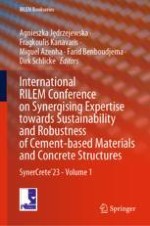2023 | OriginalPaper | Buchkapitel
Use of Recycled Carbon Fibres in Textile Reinforced Concrete for the Construction Industry
verfasst von : Vanessa Overhage, Thomas Gries
Verlag: Springer Nature Switzerland
Aktivieren Sie unsere intelligente Suche, um passende Fachinhalte oder Patente zu finden.
Wählen Sie Textabschnitte aus um mit Künstlicher Intelligenz passenden Patente zu finden. powered by
Markieren Sie Textabschnitte, um KI-gestützt weitere passende Inhalte zu finden. powered by
